A tangy, bright green cilantro sauce common in Venezuela. A big punch of salsa flavor that's not spicy, guasacaca sin aguacate sauce is the perfect fresh herb condiment for arepas, empanadas, tequeños, tacos, and more. Try this staple of Venezuelan cuisine, a delicious sauce full of fresh flavors!
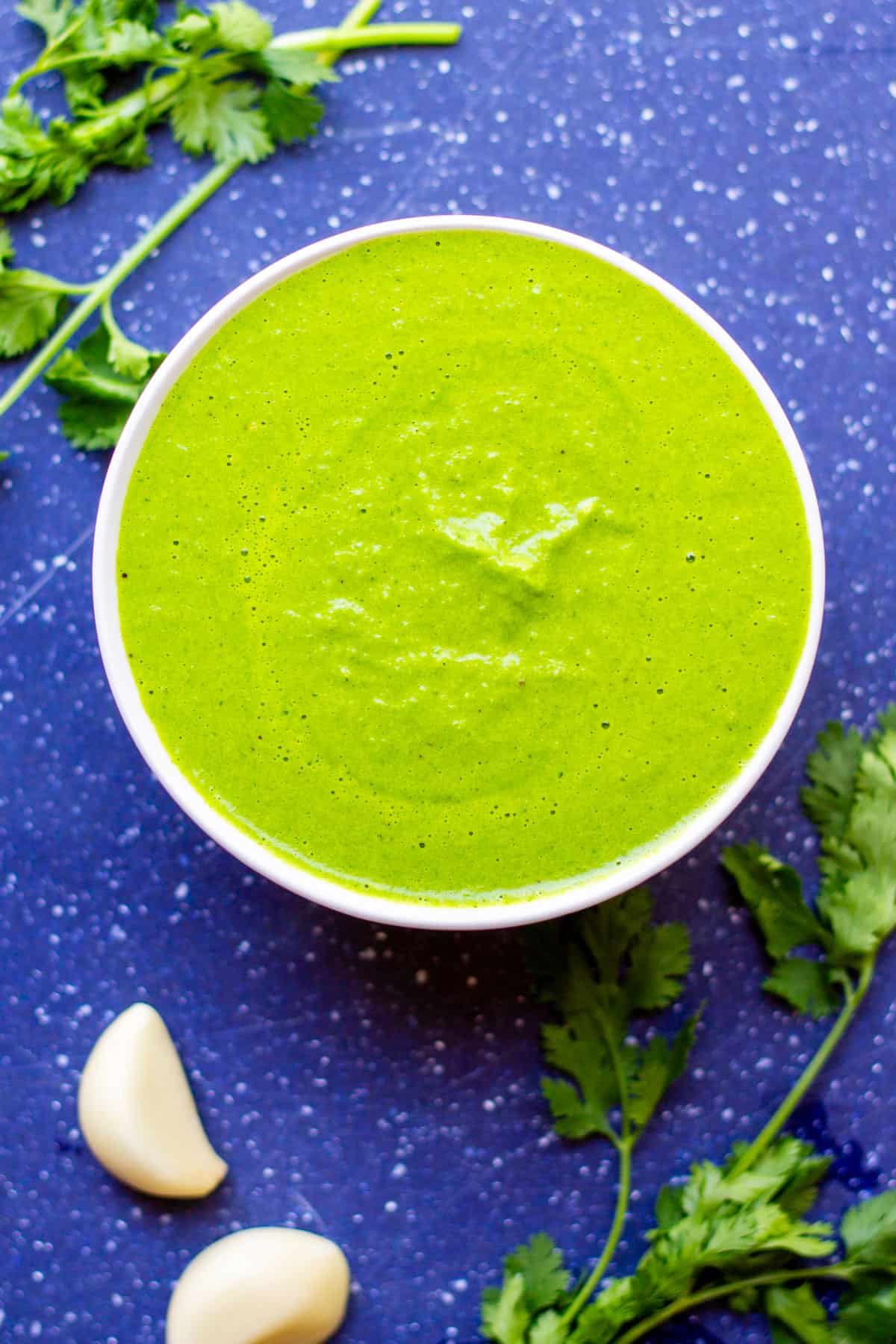
Want to save this post?
Enter your email below and get it sent straight to your inbox. Plus, I'll send you quick & simple plant-based recipes every week!
A plant-based, oil-free version of this Venezuelan guasacaca sauce is provided as well, with just one substitution.
If you're looking for guasacaca con aguacate, I now have a specific recipe for how to make Venezuelan green sauce WITH avocado as well.
Jump to:
🧄 Ingredient notes
To make this guasacaca arepa green sauce recipe, you'll need the following ingredients.
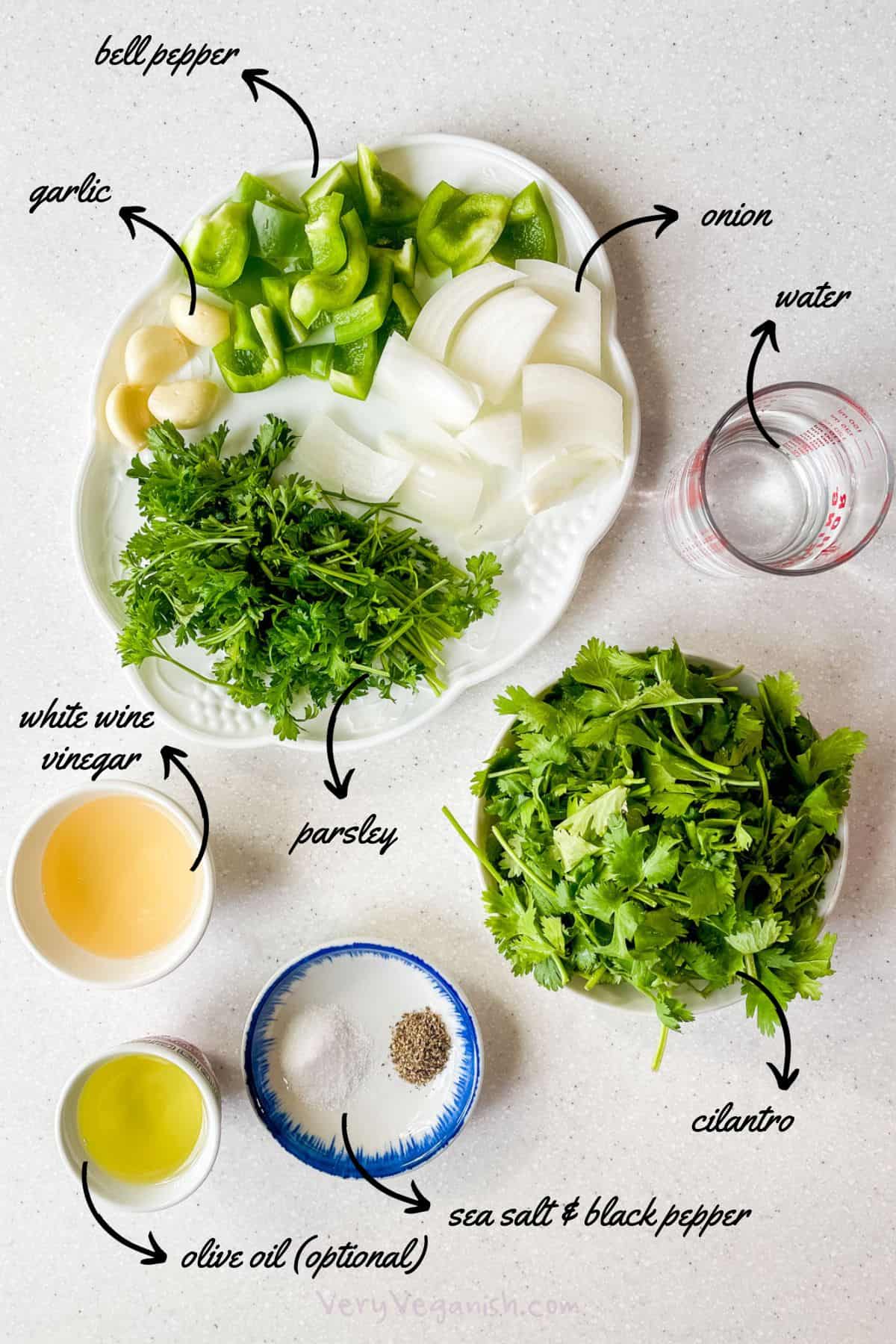
- Fresh cilantro - Lots of cilantro (coriander) is the primary flavor in this sauce. Use fresh cilantro that has been washed and any yellow or brown leaves removed. You can use the stems of the cilantro in this, so no need to tediously pluck those.
- Fresh parsley - Parsley adds more fresh flavor to this sauce. A much smaller amount of parsley is used. Be sure the parsley is washed and any yellow or brown leaves are discarded. You can use either curly or Italian leaf parsley.
- Fresh white onion - Raw white onion adds sharpness to this sauce.
- Fresh garlic - Raw fresh garlic cloves add sharpness and flavor to this sauce.
- Bell pepper - Green pepper will help preserve the bright green color of this sauce. Using a sweeter yellow, orange, or red bell pepper will make the sauce a little sweeter and reduce any bitterness that the green peppers naturally have.
- White wine vinegar - Adds brightness and acidity to the sauce
📋 Substitutions and variations
Here are some suitable substitutions for the ingredients in this Venezuelan green sauce recipe:
- Fresh parsley - instead of fresh parsley, you could use dried or frozen parsley, since it is a minor player in the sauce. But, fresh cilantro is non-negotiable.
- Fresh garlic - fresh garlic cloves is best here, but you could get away with using alternatives, such as jarred minced garlic or granulated garlic powder, if you're in a bind.
- Green bell pepper - green bell pepper has more bitterness than red, orange and yellow bell pepper, but will preserve the color of the sauce. You can use any color bell pepper you like, just know that if you want bright green sauce, it would be best to stick with green or yellow peppers. I have also used jarred roasted bell peppers, which are delicious in this sauce. If you want your guasacaca to be spicy, you could substitute the green bell pepper for spicy chiles, such as jalapeño, serrano, or habanero.
- White wine vinegar- substitute with apple cider vinegar, red wine vinegar, lime juice, lemon juice, rice vinegar or white vinegar.
- Olive oil - Traditionally, oil is used in this recipe to emulsify, thicken and preserve the color of the ingredients. For an oil-free, plant-based version of this recipe, use cooked white beans instead. Or, you can use ripe avocado (also a traditional, authentic ingredient) to thicken it and create a creamy texture. Other alternatives are cashews or sunflower seed kernels. You can also omit the oil completely and add extra water, but the sauce will discolor faster.
- WFPBNO - make this whole food plant based no oil by omitting the oil or replacing it with white beans, cashews or avocado
- SOS-free - make this SOS-free by omitting the salt and oil
Switch things up with these variation ideas!
- Spicy Guasacaca - To make this sauce spicy, add one jalapeño or serrano pepper (with seeds will make it spicier. Without seeds will make it milder). You could also add some cayenne pepper (½+ teaspoon) or hot sauce of your choice!
- Guasacaca con Aguacate - Substitute the oil for avocado and reduce the water and you have a creamy herb green sauce that is also authentic Venezuelan. This thicker, richer sauce is an alternative to Mexican guacamole, with a more tart, sharp flavor. See my Venezuelan Creamy Avocado Cilantro Salsa recipe (pictured below).
- Reduce food waste - use leftover herb stems! - Wondering what to do with leftover cilantro stems? Parsley stems? Use them to make this herb sauce! For a milder sauce, use only cilantro and parsley stems and whatever cilantro and parsley leaves you have. This is a great way to reduce food waste and use up those herb stems!
- Mixed Herb Salsa - You can also experiment with other herbs, as well like dill and basil. As long as the stems are not too woody, they would blend up. A good test to see if they're tender enough to blend? Can you break the stem easily with your fingernail? Then, they should blend up just fine in a high-speed blender.
🔪 Instructions
Making this cilantro sauce is as easy as adding the ingredients to a blender or food processor and then turning it on.
Which should you use to make this guasacaca sauce? A blender or food processor?
Well, that depends on if you're looking for a smooth sauce (this is most traditional) or a sauce with a pesto or chimichurri type of texture. If you want more parsley and oregano flavor, try this chimichurri dressing.
For a smooth, bright green sauce: use a blender
For a textured, chimichurri-style sauce: use a food processor
Here's a picture of both versions, so you can see the difference. Both have the same ingredients, but one was blended completely smooth in a blender. The other was processed in a food processor.
We enjoy both versions!
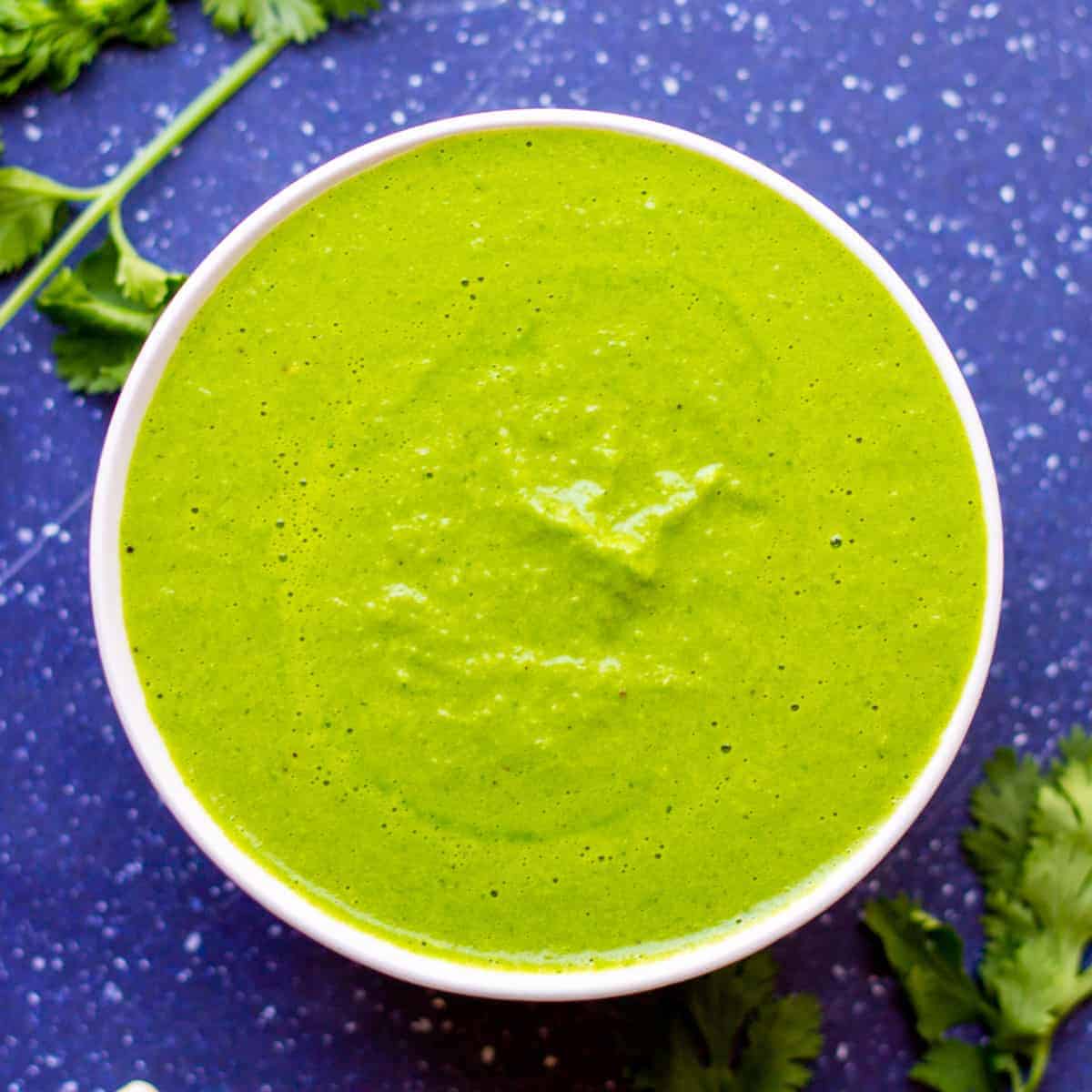
Want a smooth sauce, like this? Use a blender.
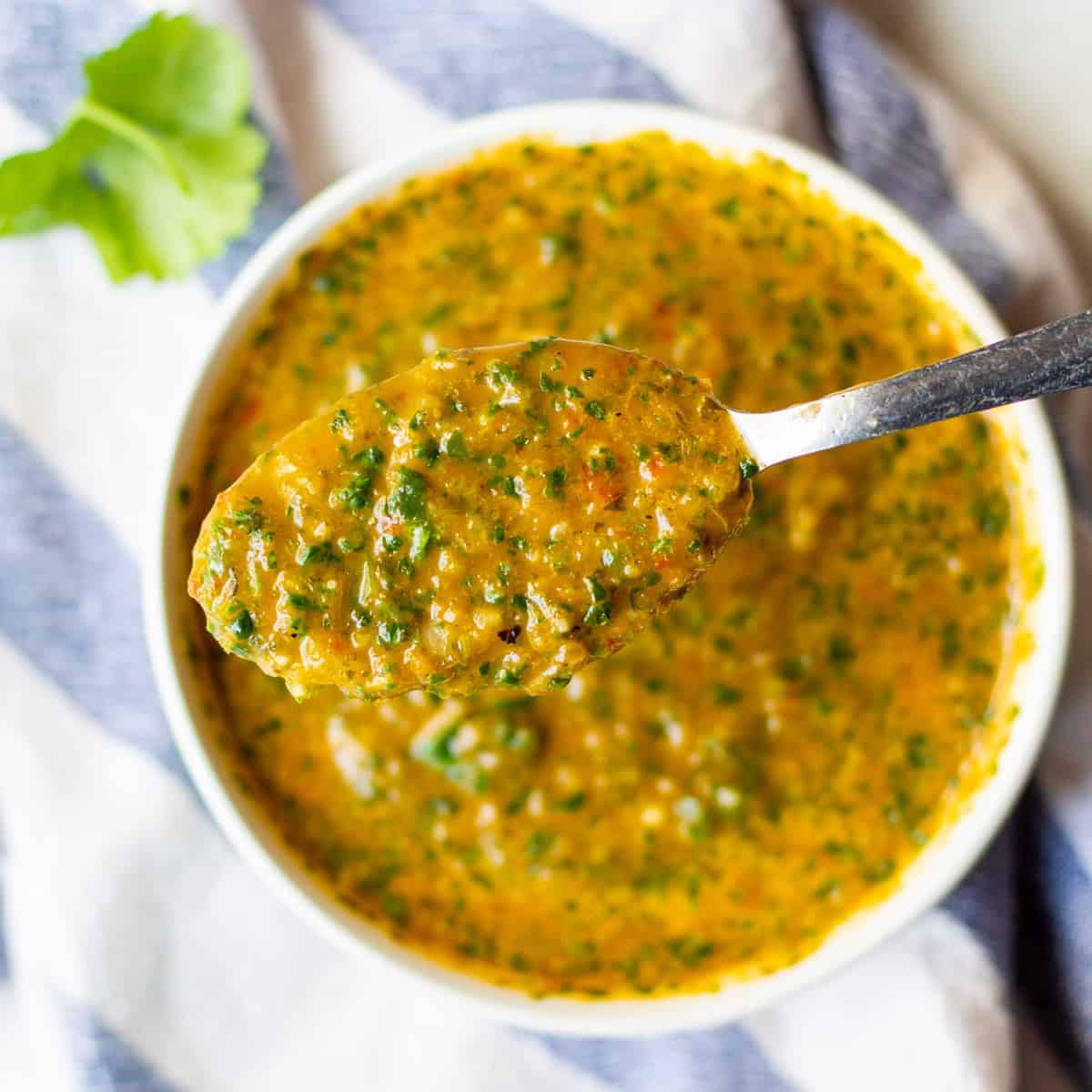
Want a textured, chimichurri-style sauce, like this? Use a food processor.
Step-by-step instructions for how to make Venezuelan green sauce in a blender
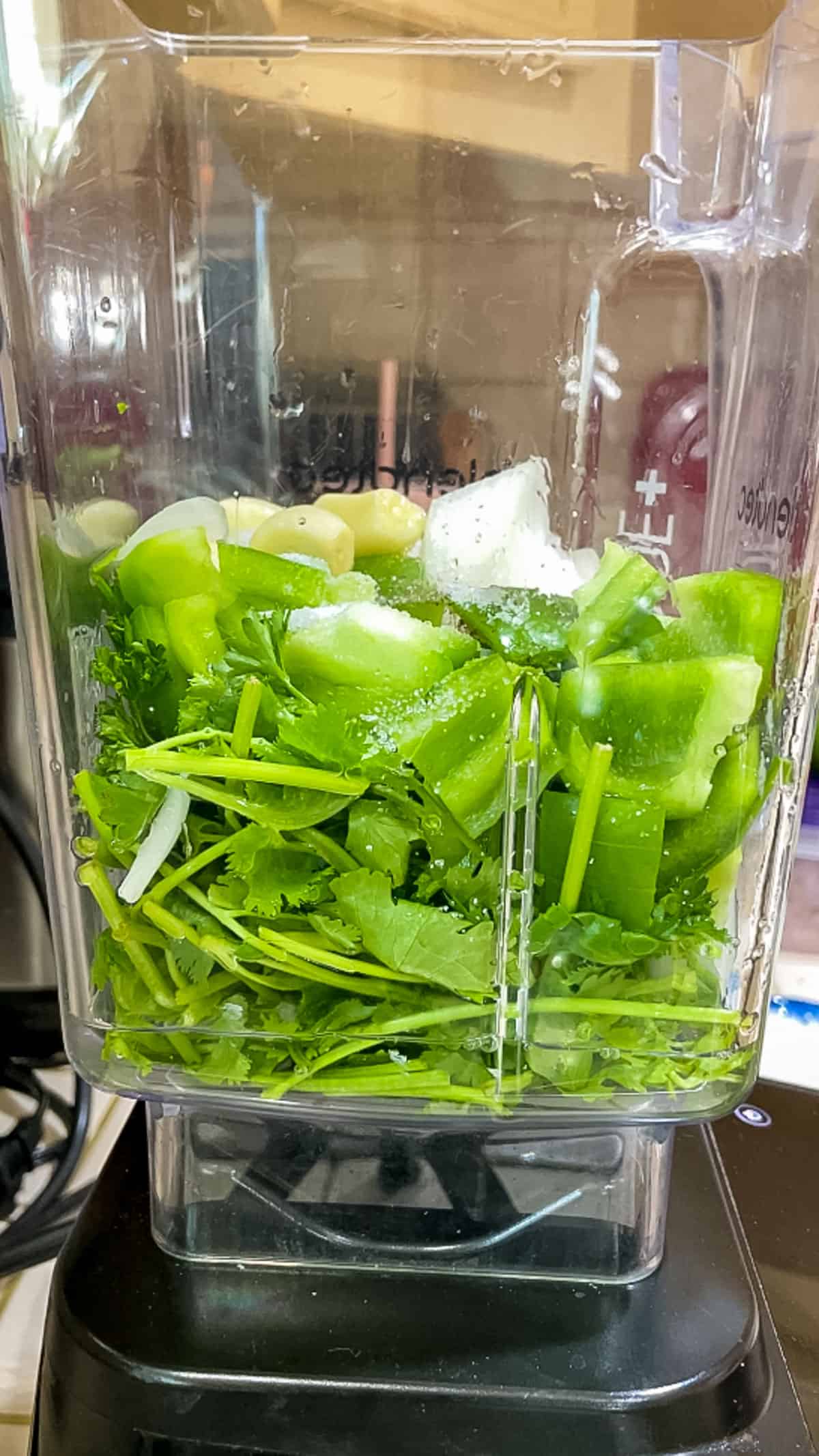
Step 1 - add all ingredients to a blender
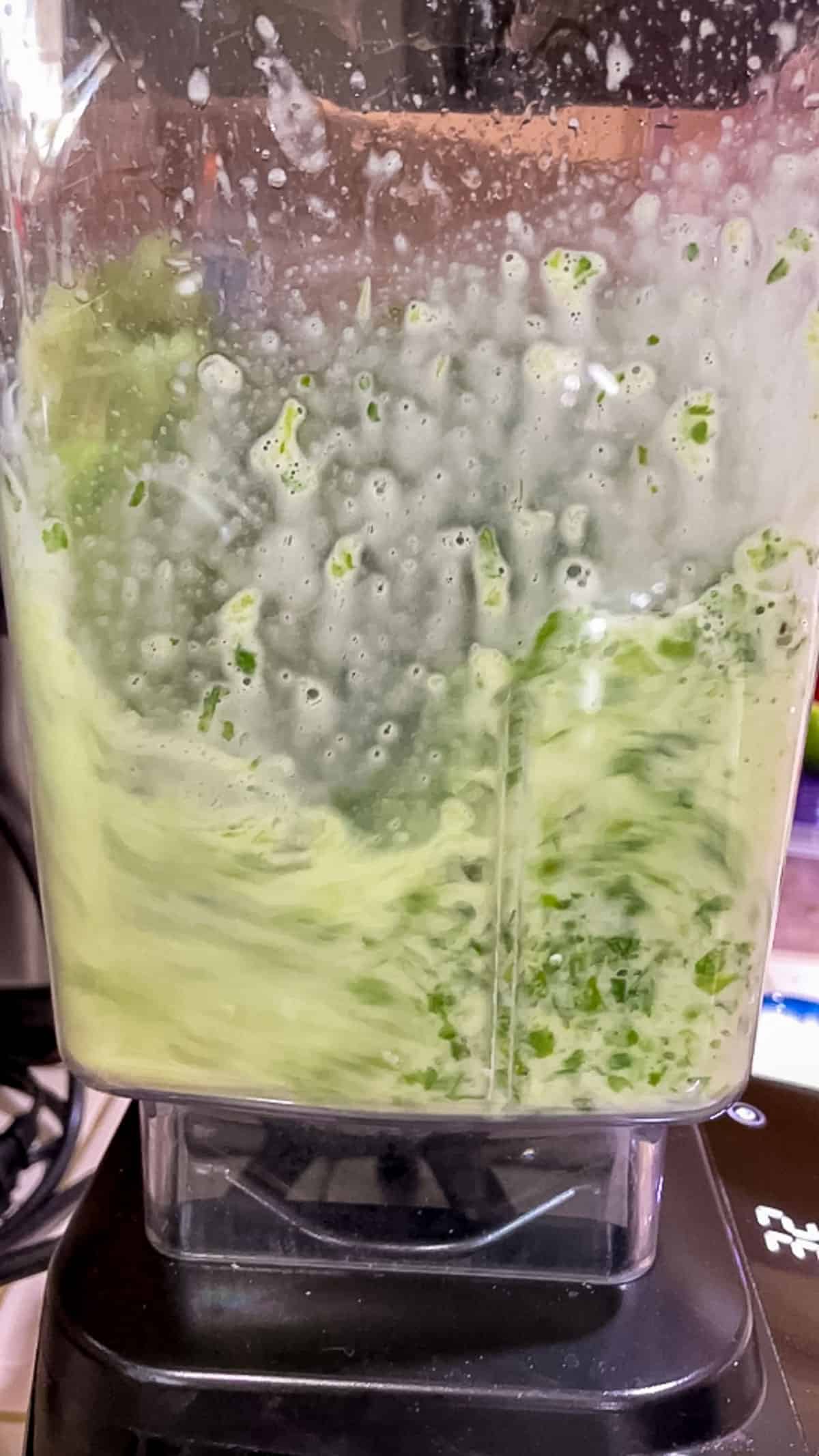
Step 2 - Put lid securely on the blender and blend until you have a smooth green sauce
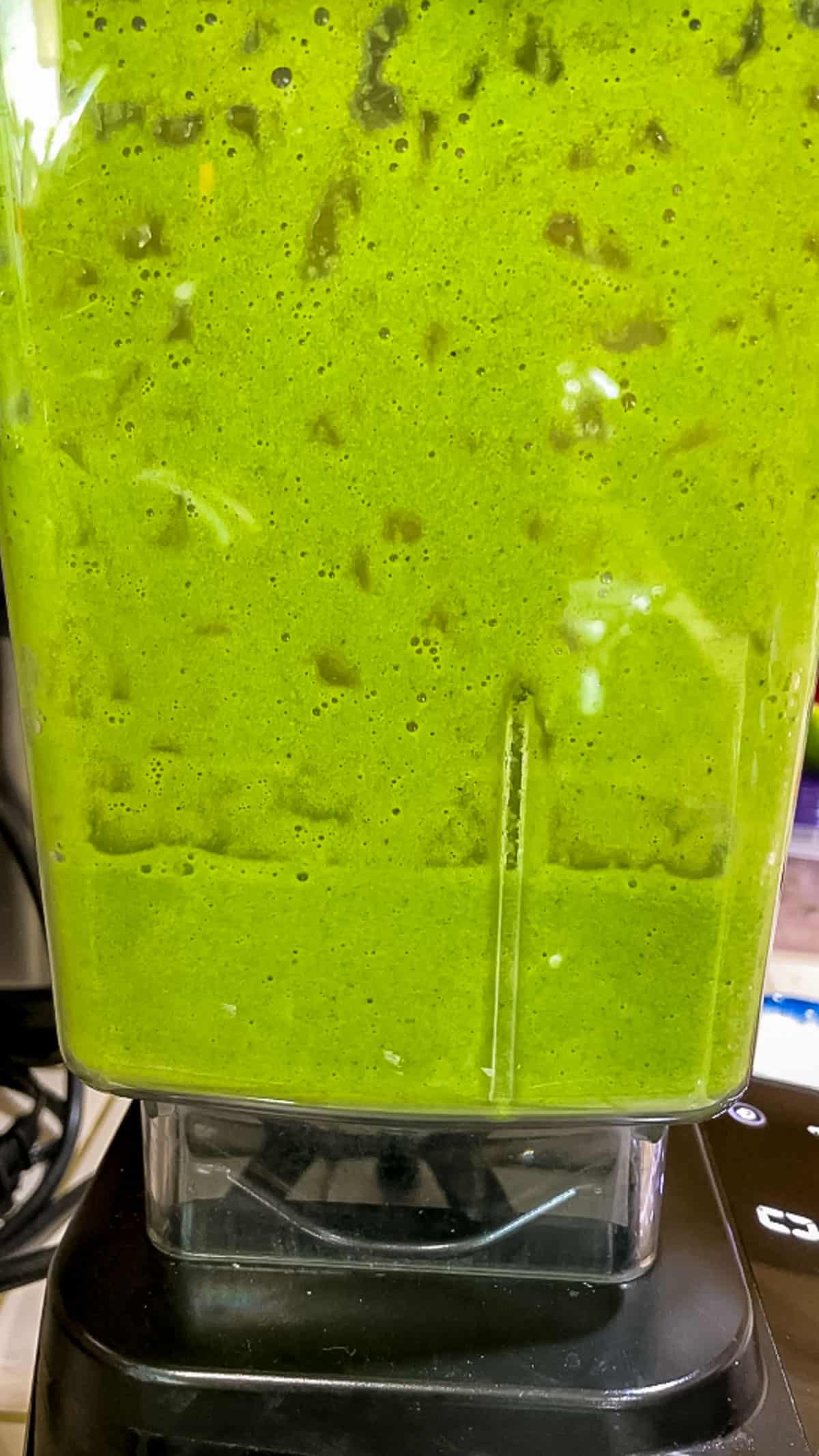
Step 3 - The sauce should be bright green and have a smooth texture when it's completely blended
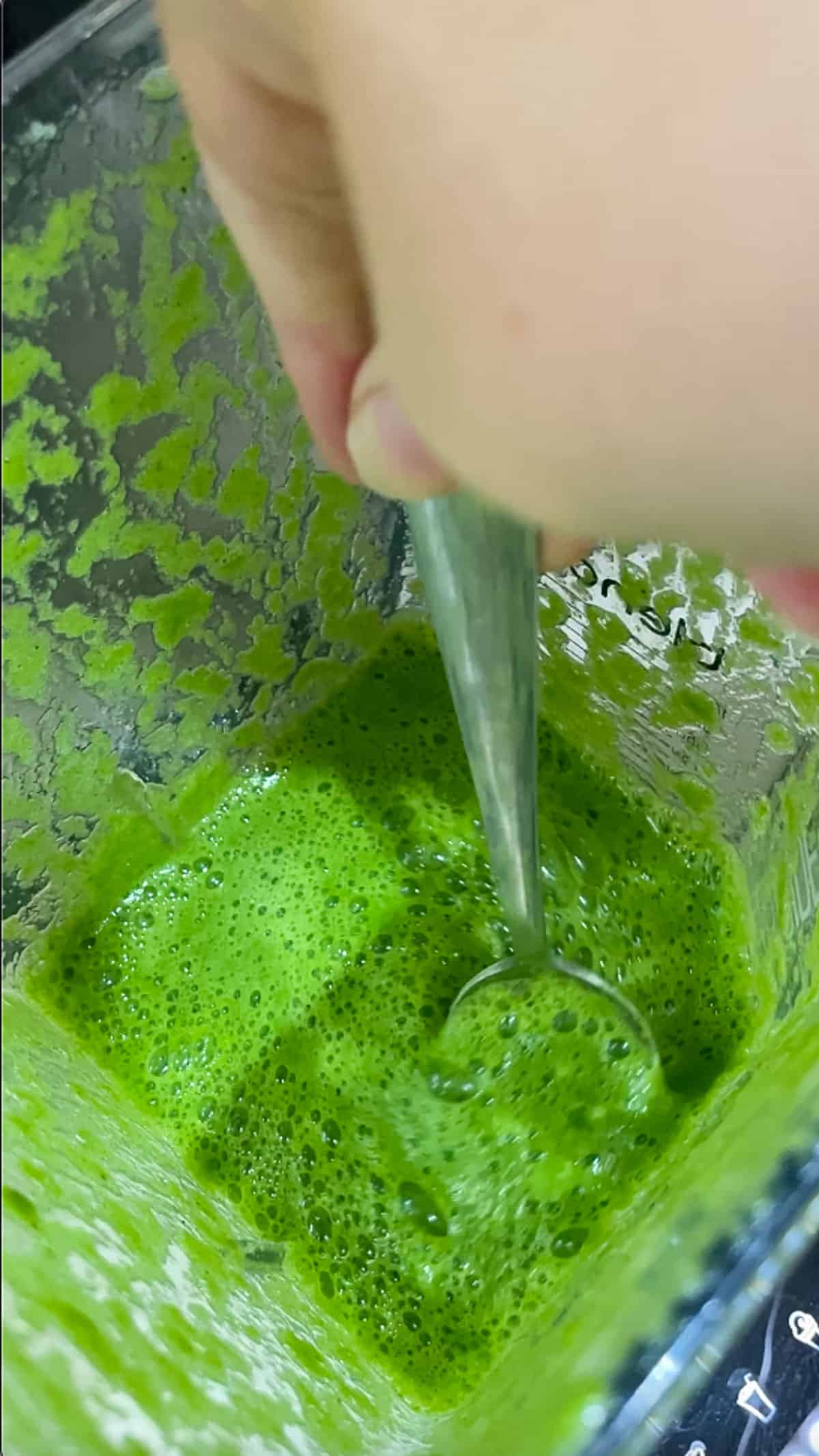
Step 4 - Taste the sauce and add more salt, if needed
Step-by-step instructions for how to make Venezuelan green sauce in a food processor
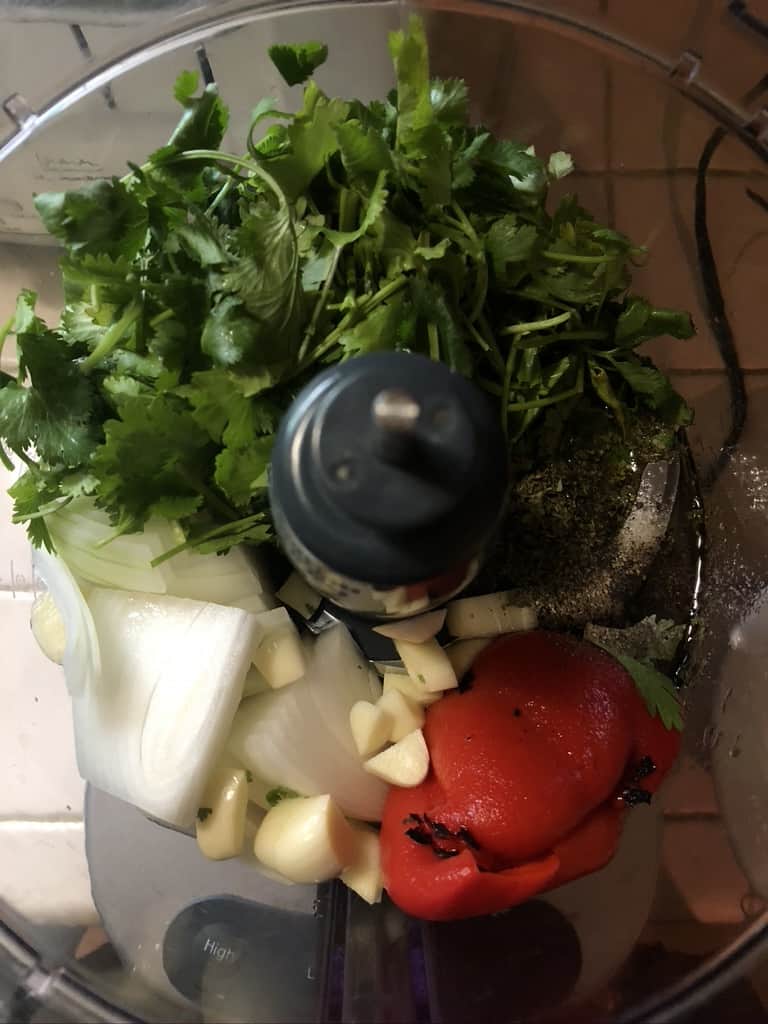
Step 1 - Add all ingredients to standard-sized large food processor.
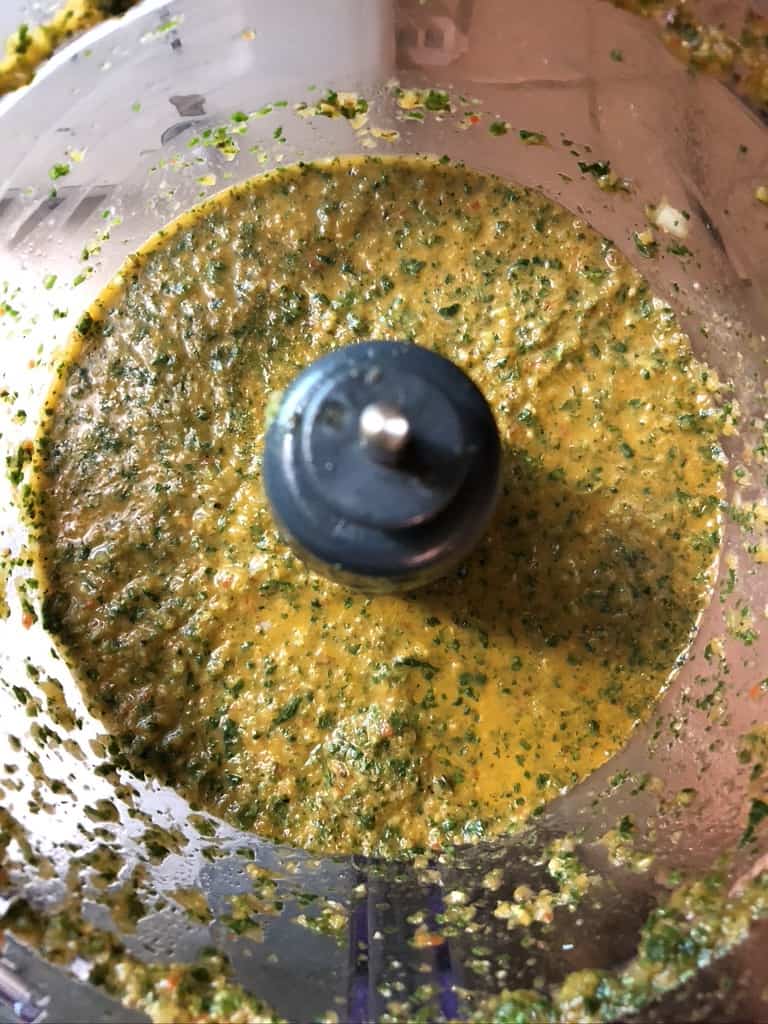
Step 2 - Process until all ingredients are broken down into a textured sauce similar to chimichurri or pesto. You may need to stop and scrape down the sides a few times.
🧯 Food safety
- Wash hands with soap and water before cooking
- Don't leave food sitting out at room temperature for extended periods
- Never leave cooking food unattended
- Be careful to avoid touching the blades of a blender or food processor, as they are very sharp and can cut you.
See more guidelines at USDA.gov.
⭐️ Expert tips
- The color of the bell pepper you use will affect the color of the finished sauce
- Use fresh herbs for the brightest flavor in guasacaca recipes
🍳 Equipment
- High-speed blender or food processor
🥡 Make ahead and storage tips
This green sauce can be made ahead of time, but for the brightest color and best flavor, make it and serve it fresh. Good for 2-3 days, if stored in the refrigerator.
This sauce turns brown when stored in the refrigerator or freezer, so I wouldn't recommend freezing it or storing it for longer than 3 days. It does not have a long shelf life.
👨👩👦👦 Serving suggestions
Arepa sauce
The #1 reason to make this Venezuelan cilantro sauce is to drizzle it over your arepas, which are common throughout Venezuela and Colombia.
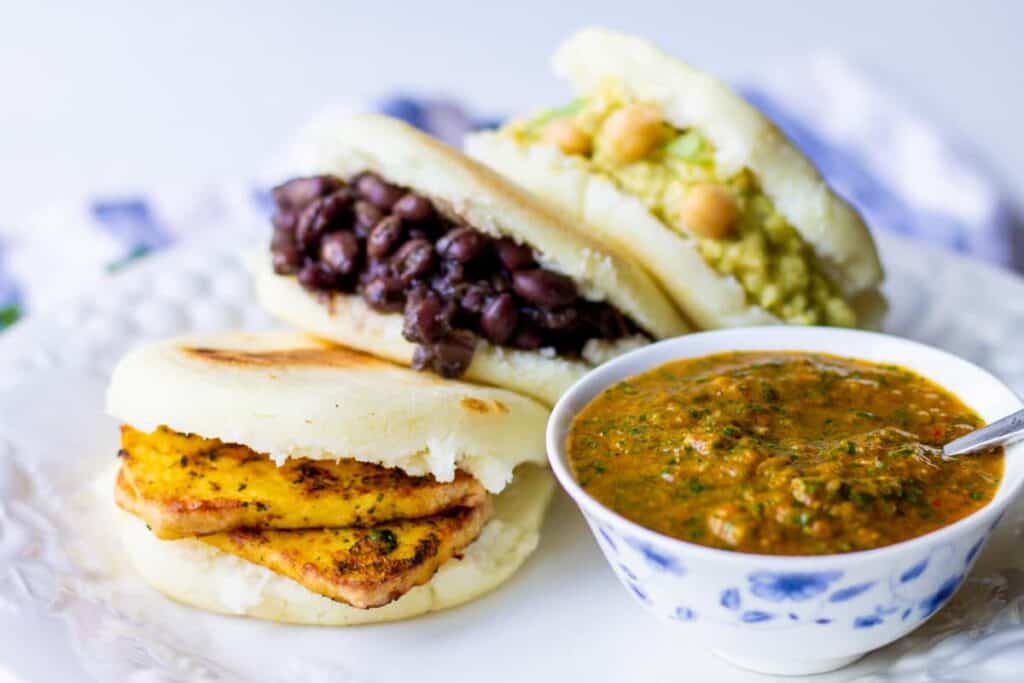
Salsa that's not spicy for tacos
If you love tacos and want a delicious, flavorful sauce to top them with, but can't handle spicy food, then try this cilantro sauce.
It's packed with herbs and aromatic veggies to give your meal a punch of flavor, without the heat.
Marinade for tofu
Marinate tofu in this cilantro sauce and then bake or air fry it. The baked tofu can then be used for sandwiches, arepas, or burrito bowls.

Add to hummus
Make a cilantro hummus by adding this cilantro salsa to your favorite hummus recipe.
Drizzle over falafel or pita pockets
The flavors in this sauce go really well with Mediterranean and Middle Eastern food, as well as Latin American, South American, Mexican, or TexMex meals.
So, use it on falafel, pita pockets, grain bowls, schawarma, kebabs, salad.
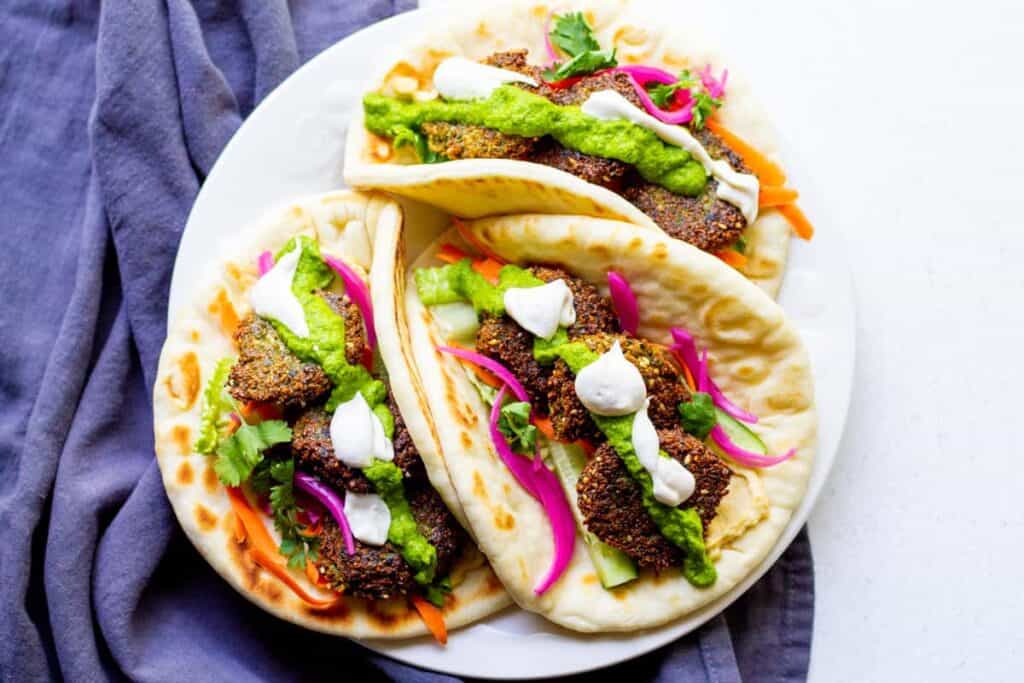
Use as a dip
Use this cilantro sauce (especially the thicker guasacaca version with avocado recipe) as a dip!
Dip your tortilla chips, corn chips, raw vegetables, pita bread in this cilantro sauce.
Add to rice for green cilantro rice
Flavor your green rice using this cilantro sauce to make green rice that's not spicy.
If you'd like for it to be spicy, you can add hot sauce to the rice or chopped jalapeño pepper.
🚦 Calorie density score
🟢 This recipe gets a green light on the calorie density chart. All of the ingredients (if you omit or substitute the oil) are lower than 600 calories per pound, so eating meals like this regularly may help you lose body fat. Learn more about calorie density from Jeff Novick, MS, RDN.
Get your own printable calorie density chart for your refrigerator and free ebook explaining calorie density in simple terms.
🗺 Cultural influences
Our Venezuelan friend Alfonso and his mother Masu taught us to make this recipe. In her cookbook this authentic recipe was labeled "Guasacaca Criolla sin Aguacate". Unfortunately, I don't have the name of the book. Here is the recipe, en Español:
Ingredientes
- 1 ramillete de cilantro
- 2 cucharadas de perejil picadito
- ½ pimentón rojo cortado en 2, sin venas ni semillas
- 1 cebolla mediana cortada en 4
- 4 dientes de ajo cortados en 4
- 3 cucharadas de Vinagre blanco
- 6 cucharadas de Aceite de girasol (maíz)
- Pimienta recién molida (al gusto)
- 1 cucharadita de sal
- 1 taza de agua
Preparación
- En una tabla se cortan las raíces al cilantro, y se agregan todos los ingredientes en el vaso de una licuadora, no colocarle toda el agua ya que a medida que mezclamos todo podemos ver si se debe agregar un poco más o no.
- La salsa debe quedar cremosa y no aguada, es por esto que se debe tener especial cuidado al agregar el agua. Se sirve la salsa en un recipiente.
Notes
- Para mezclar bien todos los ingredientes se debe prender y apagar la licuadora por espacio de 20 segundos, con esto se hace más fácil la mezcla de la salsa.
- Esta guasacaca es la que más se ve en Venezuela en Restaurantes y ventas de comida rápida.
The version with avocado would be called "Guasacaca Criolla con Aguacate".
We learned to make this sauce in order to have a sauce/condiment for the arepas he taught us to make. In Venezuela, it's served as a condiment to tequeños (breaded fried cheese sticks), meat, skirt steak, hot dogs, and french fries.
Venezuelans don't typically eat a lot of spicy things. So, you'll notice there are no spicy peppers like jalapeño or serrano chiles in this sauce. If you like spice, you could certainly add some!
In the Dominican Republic, they have a similar sauce without avocado called "wasakaka". Very similar name and similar ingredients but a different preparation.
This recipe is inspired by my mixed ethnic background and heritage as a native of Houston, Texas, and by the strong cultural influences of my friends from Venezuela. See About for more information on my cultural influences and how I attribute recipes.
💜 More recipes you'll love
If you love this Venezuelan cilantro sauce recipe, then check out my other vegan, plant-based sauces and condiment recipes!
Love this recipe? Please rate it 5 stars ⭐️⭐️⭐️⭐️⭐️ below in the recipe card. And, if you make it, please tag me on Instagram or Facebook in your posted photos! I would love to see your creations. 😄
📖 Recipe
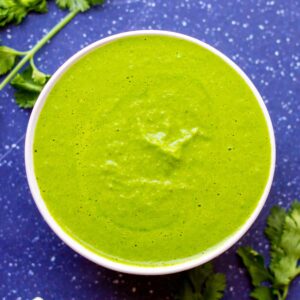
Venezuelan Cilantro Green Sauce (guasacaca criolla sin aguacate)
Equipment
- High speed blender for a smooth, blended bright green sauce
- Food processor for a sauce with texture
Ingredients
- 1 ½ cups cilantro 80g or 1 ½ packed cups fresh cilantro (leaves and stems, cut into 1 inch pieces)
- ¼ cup parsley 15g or ¼ packed cup fresh parsley (leaves and stems, cut into 1 inch pieces)
- ½ bell pepper 80g, remove seeds and veins, cut into large pieces
- ½ small onion 80g, peeled and cut into large pieces
- ½ cup water 120g
- 4 cloves garlic 15g, cut in half
- 2 tablespoons white wine vinegar 30g
- ¼ cup cooked white beans 55g drained, cooked white beans (or 3 tablespoons (40g) vegetable oil)
- ½ teaspoon sea salt
- ¼ teaspoon freshly ground black pepper
Instructions
BLENDER INSTRUCTIONS - for a smooth sauce
- BLENDER: Add all ingredients (except the avocado) to blender and blend until your sauce is smooth and bright green.1 ½ cups cilantro, ¼ cup parsley, ½ bell pepper, ½ small onion, ½ cup water, 4 cloves garlic, 2 tablespoons white wine vinegar, ¼ cup cooked white beans, ½ teaspoon sea salt, ¼ teaspoon freshly ground black pepper
FOOD PROCESSOR INSTRUCTIONS - for a textured, chimichurri-style sauce
- FOOD PROCESSOR: For a sauce with more texture (like pesto or chimichurri), use a food processor instead of a blender. Process until all the large pieces have been chopped down very fine and it looks like salsa.
- Taste and adjust salt and pepper, if needed. If your sauce is thicker than you'd like, add more water. If it is thinner than you'd like, add more white beans/oil and blend again to thicken and make it more like a dip.

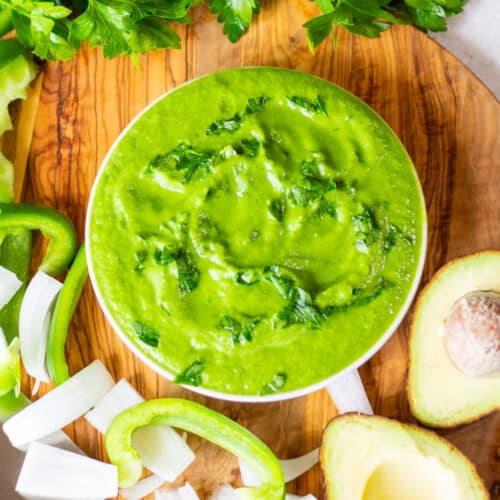
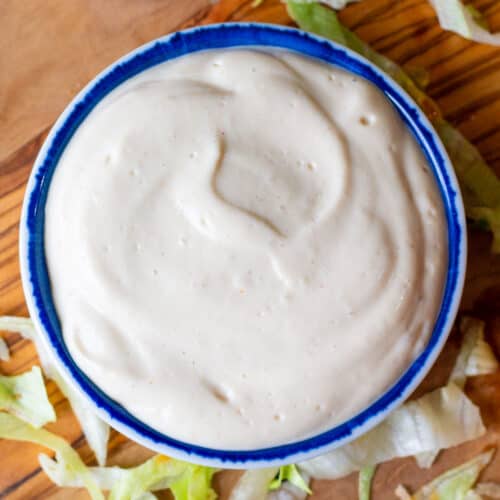
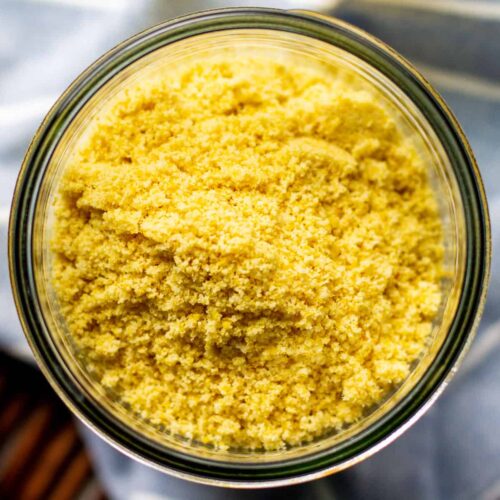


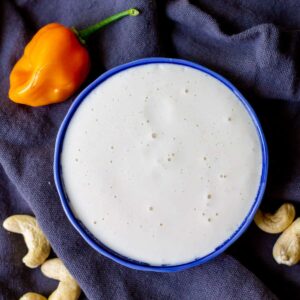

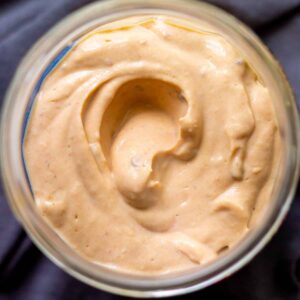

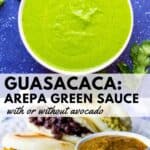
Nicollette says
Can you store this for days or does it go bad quick since there is avocado?
Abi Cowell says
I normally store it for 2-3 days in the refrigerator. But, it is much better fresh, especially the avocado version. If you need to make it ahead of time, perhaps adding a bit of lemon juice in place of the vinegar in the recipe will help it to last a bit longer. But, it will alter the taste a bit.